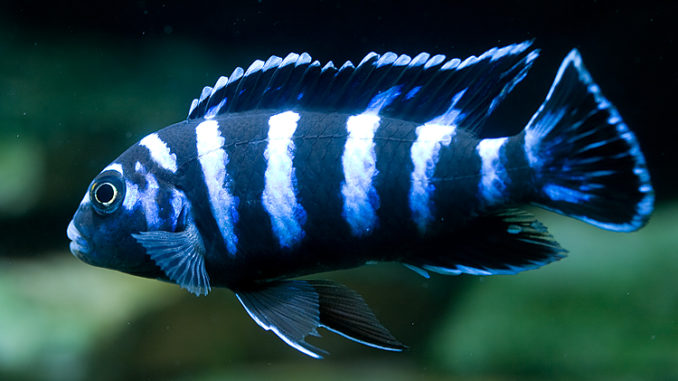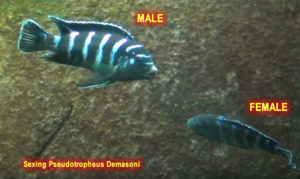
A very popular and sort after cichlid slightly smaller variety of Mbuna is the pocket rocket Pseudotropheus Demasoni. Their striking blue and black bands make them stand out amongst most cichlids. Living out of the rocks in an aquarium, they are territorial by nature but generally a really good addition to the African cichlid aquarium setup.
Common Name(s) : Demasoni

Family : Cichlidae
Genus : Pseudotropheus
Species : Pseudotropheus demasoni
Maximum Size : 8-10cm / 3.3-4 inches
Lifespan : 8-10 years
Aggression Level : Aggressive and territorial (8.5/10)
PREFERRED WATER CONDITIONS
Tank Size : 60 Litres +
PH : 7.5 – 8.5
Hardness : Moderate to Hard
Temperature : 23 – 26°C / 73.4–78.8 °F
TANK SET UP
In the wild they inhabit rocky areas in large groups, often in shallow water around the tops of the rocks. They occur around Pombo Rocks off the Tanzanian coast of Lake Malawi.
To replicate this environment in the home aquarium, add plenty of rocks creating caves and nooks and crannies to a reasonable height. If you only have one or two caves then these guys will try to dominate tank mates at a relentless level. Getting a small school of them tends to keep them in check a bit better we find.
SUITABLE TANK MATES
- Other African cichlids (of similar size)
- Clown Loaches, Featherfin Catfish, Cuckoo Catfish, Bristlenose Catfish, Plecos, Ghost Knives
- They can also sometimes live with barbs, American cichlids, Larger Gourami’s, Eels, Silver & Golden Perch, larger sharks, silver dollar and yabbies.
DIET
In their natural environment they pick at algae for food which may contain Aufwuchs. Aufwuchs is tough stringy algae that is attached to rocks. In amongst this string type algae they will also find and eat insect larvae, nymphs, crustaceans, snails, mites and zooplankton.
Good foods for them in the home aquarium is algae pellets and vegetable matter (maybe stick a fork in a chunk of zucchini or cucumber.) A good quality cichlid food such as flake or pellet should suffice as a staple diet. Supplement them with some frozen brine shrimp or bloodworm from time to time.
SEXING AND BREEDING
Demasoni are difficult to sex – their colours in male and females are identical. In fully developed specimens, males will appear larger.
The easiest way to sex it is by observing their behaviour in the aquarium. As with other mbuna males are the more territorial sex and are often seen chasing females and other species in the tank.
When the breed these fish are known as Ovophiles. Ovophiles are mouthbrooding members of the Cichlidae family of fish (cichlids). Ovophiles dig pits or holes in which the female lays eggs. The female lays eggs in this pit and then immediately takes the eggs into her mouth. The male then fertilizes the eggs in the female’s mouth.
In some species, the male’s anal fin is covered with circular markings that, to a female, look confusingly like eggs. Female will attempt to bring the male’s tail into their mouth and, at the right moment, the male will ejaculate into their mouths, fertilizing the eggs.
Examples including the include the Aulonocara, Haplochromis and Pseudotropheus, and Labidochromis caeruleus.
